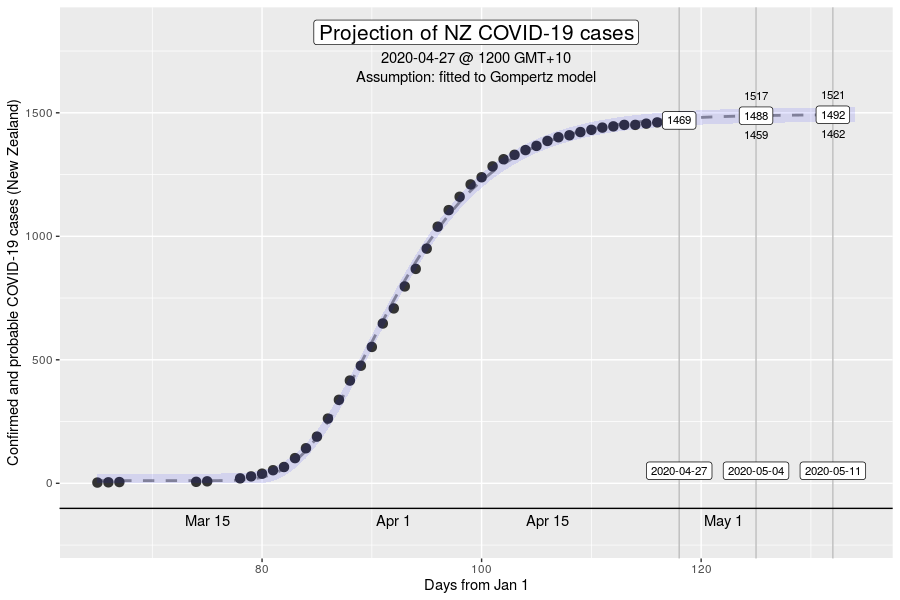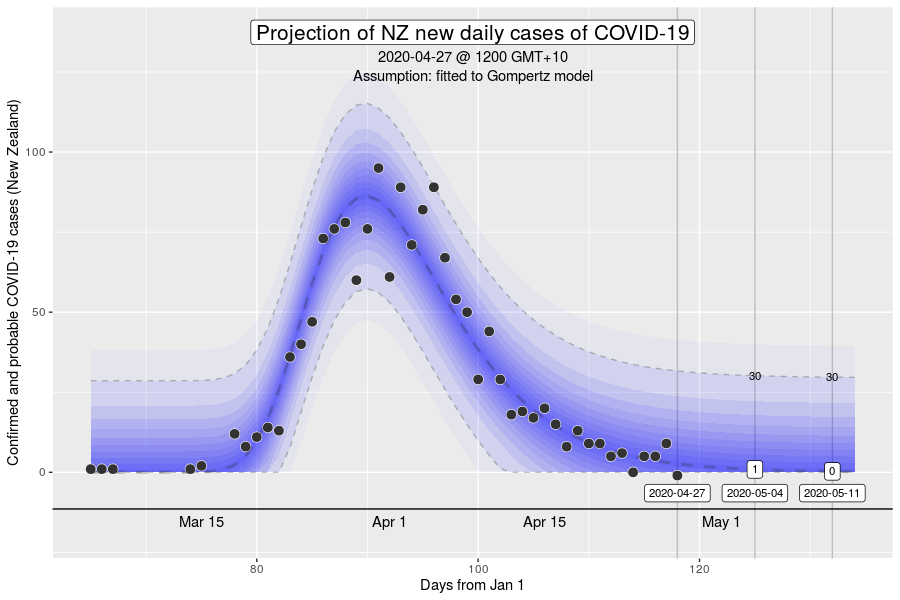I restarted the analyses from early July 2020 with the onset of the new Melbourne outbreak. The logic behind these charts is that they fill an information gap. Official data sources only give historic data series, and mainstream media typically only give near term predictions based on opinion.
Chart update 26 July 2020
What’s new?
Today’s new number of cases, 475 as per the Australian Department of Health 26/7/2020 update is largely consistent with the projected estimate of the model. Although we have to be cautious with being overly optimistic with early trends, there has been a downwards bending of the model projections over the past three days. I am hopeful this might be an early signal that transmission rates are being controlled. We have had some large fluctuations in the past week so will have to watch and wait. We are now over two weeks into the stage 3 restrictions (“lock down”) of Melbourne, which started on 9 July 2020. Up to now, it appears that transmission has not been adequately suppressed (from a whole-of-system perspective, not just about the “lock down”).
My experience with this model from the March 2020 was that projections from early on in the epidemic tend to underestimate slightly in the short-term (days), and overestimate in the longer-term (weeks). This bias is something to keep in mind.
Projection of new daily cases of COVID-19 with data up to 26 July 2020
What is this?
The image is a chart of the confirmed daily new cases of COVID-19 in Australia, with a projection for the next 2 weeks. The projection is made using a model by fitting the data since 1 June 2020 to a Gompertz equation using non-linear regression. The dark blue dashed line is the model estimate. The grey dashed lines are the 95% prediction intervals, with the values given at 7 and 14 days into the future. The blue gradations can be understood as the degree of uncertainty in the model projections.
“Gompertz” equation?
The Gompertz function is a type of sigmoid, or “S”-shaped curve. It’s been around since the early 19th century and was initially used to describe and model demographic mortality curves, and hence, well known to actuaries. The Gompertz function can also be used to accurately model biological growth (e.g., epidemics, tumour size, enzymatic reactions). I have chosen to use this model to help with creating insights as earlier in the pandemic, it was found to be useful in modelling cumulative cases of COVID-19 from the Chinese outbreaks (Jia et al. arXiv:2003.05447v2 [q-bio.PE]). My experience from the initial outbreak from earlier in the year was that this equation gave reasonable descriptions of Australian and New Zealand data (for instance, NZ data below).


How have the model projections changed over the month?
The video demonstrates how the projections have evolved over time as new daily data have become available. This can give a better sense of where we are headed, given that the model cannot account for changes in context (e.g., policy changes, changes in testing rates, etc.)
My interpretation
Today’s case count is consistent with the model. The Australian and New Zealand experience of the March-April outbreak give us perhaps the best indication of what the curve would look like if policies to reduce transmission of coronovirus were effective. For both Australia and New Zealand, daily new case counts reached its peak roughly a week after the implementation of the “lock down” policies. We are now over two weeks into the Melbourne lock down.
Below is a chart using the same methodology from during the period March to April, as compared to the current outbreak. As a reminder, the first “lock down” started on 23 March 2020.
Projections of new daily cases of COVID-19 from March-April outbreak compared to the current July outbreak, at 10 days after lock down
Notably, this chart from the first wave remains very different to the projections today.
It is clear that the current outbreak has not responded to policy interventions as quickly as the outbreaks in March-April. However, in the past three days, the model has had a clear downwards change in the overall projections – with a lower peak that has moved closer to the present. These are hopeful signs, though we will need to watch and wait to see whether it is an ongoing trend.
There remains concern with the daily number of cases in NSW at multiple locations across Sydney and the state. Although new daily numbers haven’t climbed in the past week, the most parsimonious explanation remains hidden community transmission, originating from the Melbourne outbreak. Widespread testing and contact tracing is taking place, along with improving physical distancing adherence and use of masks. Hopefully, it will be enough.
More information about the “peak” in new cases
So according to the current model, when will the peak arrive? This remains very uncertain but does seem to have moved closer. If we naively accept the model projection estimates into the medium term (WE SHOULDN’T), the model today would indicate a peak in about a fortnight in early to mid-August at around 500 cases per day.
What does it mean to have reached the peak in new cases? It’s important to recognise that although this is a welcome milestone in an outbreak, it is not the “half-way point”, which might be the intuition. The peak in the “new cases” curve corresponds to the “inflexion point” on the S-shaped culmulative cases curve (e.g., the first chart of the NZ cases in the brief description on the “Gompertz equation”. Roughly, the peak in new cases occurs at 40% of the total culmulative cases in an outbreak. That means that at the time we hit the peak, we can expect another one-and-a-half times the number of cases so far in the outbreak, before it ends. The insight is that we must resist the psychological temptation to relax transmission control mechanisms simply because we “crossed the peak”.
Want to know more?
Primary data source is the Australian Government Department of Health COVID-19 website for daily new cases. Analysis done using RStudio Cloud using R version 4.0.2.
Today’s charts
Projection based on data up to 2 April 2020
Data: 20200427 – COVID_AU-world
R code: covid_au-world-21
